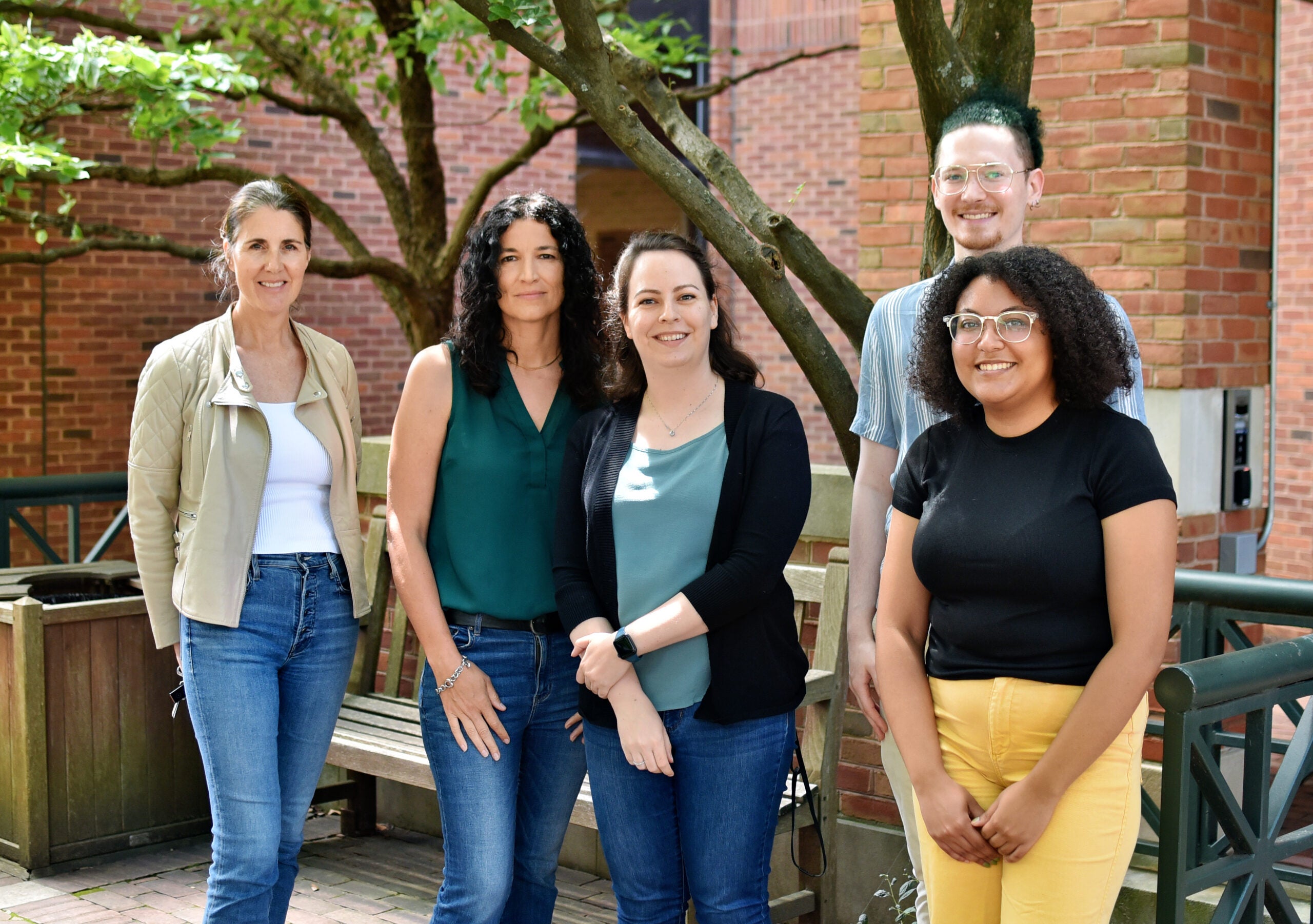Judith A. Woodfolk, MD, PhD
 PRIMARY APPOINTMENT:
PRIMARY APPOINTMENT:
Professor of Medicine
Co-Director, UVA Medical Scientist Training Program
CONTACT:
UVA Division of Asthma, Allergy, and Clinical Immunology
PO Box 801355
MR-4, 5061
Telephone: 434-924-1293 / 434-982-3958
Fax: 434-924-1251
Email: jaw4m@virginia.edu
RESEARCH AREAS:
Immunology, Microbiology, Molecular Biology, Translational Science
RESEARCH SUMMARY
Overview
The Woodfolk lab studies the immune response to respiratory viruses.
We use translational models to understand how immune cells respond to viruses in health and disease. We aim to identify biomarkers predicting severe outcomes in at-risk patients and identify new strategies to prevent virus-induced lung damage.
Infection with rhinovirus, the major cause of the common cold, typically runs a benign course. However, in patients with asthma, rhinovirus exposure triggers acute wheezing episodes that often require hospitalization. We have characterized T cells and B cells that define a protective response to rhinovirus and established a previously unrecognized role for type 1 immunity in promoting allergic asthma. The analytical pipelines developed for rhinovirus have since laid the groundwork for work on SARS-CoV-2, the causative agent of COVID-19.
- Studying Hallmarks of Protective Immunity to Rhinovirus Infection. Infections caused by the more than 150 strains of rhinovirus that are endemic in the United States account for over half a billion cases of common cold annually. Despite this, there is no vaccine or proven treatment for rhinovirus infection. We recently identified CCR5+ T cells in the blood that can respond to multiple rhinovirus strains. We are using a human experimental model that involves sequential infections with two different rhinoviruses A strains to identify cellular and molecular elements of the adaptive response that mediate cross-protection against multiple rhinovirus strains. This includes the use of novel computational algorithms to analyze spectral flow cytometry datasets to pinpoint complex cell phenotypes in the blood that relate to infection outcomes. Our findings have the potential to create novel vaccines and strategies for the treatment of the common cold. Work is supported by NIH/NIAID.
- Understanding the Role of Rhinovirus-Specific T Cells in Asthma. Infection with rhinovirus is a major trigger of acute wheezing episodes in patients with allergic asthma. Our recent data suggest that rhinovirus-specific Th1 cells can drive airway inflammation in asthma, even when no infection is present. We have developed high-throughput analytical pipelines for virus-specific T cells that allow us to probe the transcriptome for pro-inflammatory pathways operating in these cells. In a rhinovirus challenge model, we are testing the capacity for cytokine blockade to disrupt these pathways and to re-program the immune response to rhinovirus in asthma. Work is supported by NIH/NIAID and Regeneron Pharmaceuticals.
- Defining Protective and Pathogenic Immune Responses in SARS-CoV-2/COVID-19. We are using high-dimensional immune profiling to understand the nature of the immune response to SARS-CoV-2 in health and disease. This includes developing novel tools to precisely characterize virus-specific T cells that respond to vaccines and defining how T cells contribute to lung damage in patients with post-COVID syndrome who fail to successfully recover from COVID-19 infection. These projects involve long-term immune monitoring of highly characterized Vaccine and Recovery Cohorts and extensive interactions with clinical experts in order to link immune findings to clinical outcomes.
- Assessing the Immunomodulatory Potential of Hypoallergenic Molecular Variants. Sensitization to dust mite allergens is common, and these allergens are potent inducers of IgE antibodies. Recombinant allergens that display reduced IgE binding provide a safe alternative to current immunotherapies for allergic disease. Ongoing work seeks to test the T cell modulatory potential of such hypoallergenic molecules.
Precision Medicine: Our methods combine state-of-the-art single-cell technologies and analytical tools with clinical data to construct the landscape of immune activation and its evolution over time. Our analytical pipelines allow us to link specific immunophenotypes to clinical outcomes. Assessing the response in various scenarios may inform personalized approaches to therapy.
Examples include:
- Assessing the influence of genetic factors, asthma severity, and other co-morbidities on the immune response to respiratory viruses and vaccines.
- In a randomized controlled study, monitoring the response to type 2 cytokine blockade in patients with asthma.
- Tracking the response to milk avoidance in patients with eosinophilic esophagitis (planned).
External Collaborations:
Dr. Jonathan Irish – Vanderbilt University, Nashville, TN.
Dr. William Kwok – Benaroya Research Institute, Seattle, WA.
Dr. Anna Pomes – Indoor Biotechnologies Inc., Charlottesville, VA.
CURRENT LABORATORY MEMBERS

Judith Woodfolk, Glenda Canderan, Lyndsey Muehling, Paul Dell, and Naomi Bryant
 Glenda Canderan, PhD
Glenda Canderan, PhD
Research Assistant Professor
(Bio coming soon)
 Lyndsey Muehling, PhD
Lyndsey Muehling, PhD
Research Assistant Professor
(Bio coming soon)
 Naomi Bryant, MS
Naomi Bryant, MS
Graduate Research Student
(Bio coming soon)
 Paul Dell
Paul Dell
Graduate Research Student
(Bio coming soon)
- Bryant N, Muehling LM, Wavell K, Teague WG, Woodfolk JA. Rhinovirus as a driver of airway T cell dynamics in children with treatment-refractory recurrent wheeze. JCI Insight. 2025 May 8;10(9):e189480.
- Canderan G, Muehling LM, Kadl A, Ladd S, Bonham C, Cross CE, Lima SM, Yin X, Sturek JM, Wilson JM, Keshavarz B, Enfield KB, Ramani C, Bryant N, Murphy DD, Cheon IS, Solga M, Pramoonjago P, McNamara CA, Sun J, Utz PJ, Dolatshahi S, Irish JM, Woodfolk JA. Distinct type 1 immune networks underlie the severity of restrictive lung disease after COVID-19. Nat Immunol. 2025 Apr;26(4):595-606.
- Ayers E, Canderan G, Williams ME, Keshavarz B, Portell CA, Wilson JM, Woodfolk JA. In-depth cellular and humoral dynamics of the response to COVID-19 vaccine booster in patients with chronic B-cell neoplasms. Blood Cancer J. 2023 Jul 26;13(1):114.
- Muehling LM, Heymann PW, Carper H, Murphy DD, Rajadhyaksha E, Kennedy J, Early SV, Soto-Quiros M, Avila L, Workman L, Platts-Mills TAE, Woodfolk JA. Cluster analysis of nasal cytokines during rhinovirus infection identifies different immunophenotypes in both children and adults with allergic asthma. Clin Exp Allergy. 2022 Oct;52(10):1169-1182.
- Barone SM, Paul AG, Muehling LM, Lannigan JA, Kwok WW, Turner RB, Woodfolk JA, Irish JM. Unsupervised machine learning reveals key immune cell subsets in COVID-19, rhinovirus infection, and cancer therapy. Elife. 2021 Aug 5;10:e64653.
- Muehling LM, Heymann PW, Wright PW, Eccles JD, Agrawal R, Carper HT, Murphy DD, Workman LJ, Word CR, Ratcliffe SJ, Capaldo BJ, Platts-Mills TAE, Turner RB, Kwok WW, Woodfolk JA. Human Th1 and Th2 cells targeting rhinovirus and allergen coordinately promote allergic asthma. J Allergy Clin Immunol. 2020 Sep;146(3):555-570.
- Eccles JD, Turner RB, Kirk NA, Muehling LM, Borish L, Steinke JW, Payne SC, Wright PW, Thacker D, Lahtinen SJ, Lehtinen MJ, Heymann PW, Woodfolk JA. T-bet+ Memory B Cells Link to Local Cross-Reactive IgG upon Human Rhinovirus Infection. Cell Rep. 2020 Jan 14;30(2):351-366.e7.
- Muehling LM, Turner RB, Brown KB, Wright PW, Patrie JT, Lahtinen SJ, Lehtinen MJ, Kwok WW, Woodfolk JA. Single-Cell Tracking Reveals a Role for Pre-Existing CCR5+ Memory Th1 Cells in the Control of Rhinovirus-A39 After Experimental Challenge in Humans. J Infect Dis. 2018 Jan 17;217(3):381-392.
- Wisniewski JA, Muehling LM, Eccles JD, Capaldo BJ, Agrawal R, Shirley DA, Patrie JT, Workman LJ, Schuyler AJ, Lawrence MG, Teague WG, Woodfolk JA. TH1 signatures are present in the lower airways of children with severe asthma, regardless of allergic status. J Allergy Clin Immunol. 2018 Jun;141(6):2048-2060.e13.
